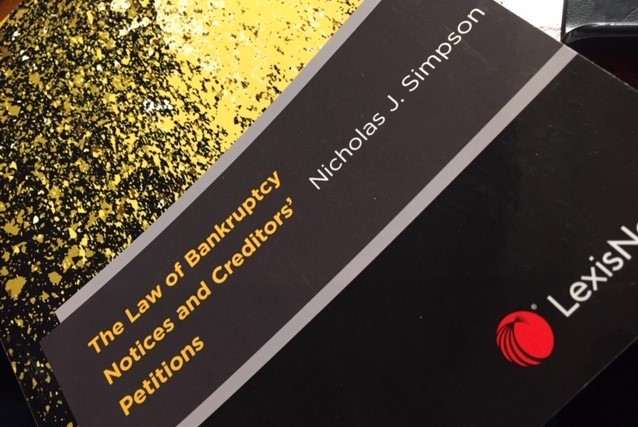This is a very good and topical Australian text, adequately and accurately described by its title. My review of it was/is to appear in the expected December issue of the Insolvency Law Bulletin, but publication of that issue is delayed until 2021.
So I publish my review here, in 2020.
As some Judges have more or less said, if a creditor is applying to put an individual debtor into bankruptcy, it can at least get the legal process right. Bankruptcy has serious legal consequences and a creditor’s compliance requirements are strict. And much hinges on getting it right, given that the act of bankruptcy based upon non-compliance with a bankruptcy notice can determine the defined ‘commencement’ of the bankruptcy and indeed the grounding of the court to make sequestration order.
Nicholas Simpson’s six chapter text starts with a very useful account of the long history of bankruptcy and our present Bankruptcy Act 1966. Legal history is too little covered in texts, and this puts the topics of the book and their importance in a relevant and useful context.
The next two chapters deal with the law and case law on bankruptcy notices, and debtors’ challenges to them; followed by the next three chapters in time sequence order – preparing the creditor’s petition, invariably based on the act of bankruptcy created by the notice, the court hearing, and the various bases of contest.
For my own interest, I looked for some particular issues, and found them all well covered: that although the debtor does not challenge a notice at the time of its service, it may still be held to be invalid some long time later, thereby depriving the court of power to make a sequestration order: [6.9] and Re Pollard; issues with debtors overseas and their necessary connections with Australia, such as being ‘ordinarily resident’ here: [4.21] Re Taylor; the application of the slip rule, or otherwise, when a petition is adjourned beyond its life of two years: [4.31] Luck v University of Southern Queensland; and defending a petition on the grounds of solvency [6.31] Re Sarina.
The book does not refer to one of my perversely favourite cases – Shannon & Middleton v King[1] – where the issue was whether the use of the term “creditor(s)” instead of “creditor” rendered a bankruptcy notice invalid, the debtor relying upon evidence from a Professor of Linguistics and a 90-page affidavit by an articled clerk, all described by the Court as “a complete waste of time and effort”.
That decision illustrates the overly technical approach to the validity of bankruptcy notices, evident to only some lesser extent in a series of earlier cases reported by the Bulletin displaying serious dissension among Federal Court judges as to the principles to be applied under the remedial section 306(1).[2] That led to a test case before a five member bench, which then split three:two. Only when an appeal heard by the High Court in another matter was the issue resolved, in favour of the minority two: Adams v Lambert, a decision which the book explains throughout and well [3.50] and which seems to have restored a level of consistency in judicial decisions.
The focus on such highly technical challenges was a reason for the 1988 Harmer Report (unsuccessfully) recommending that the underlying features of relation back and acts of bankruptcy be reformed. Those unactioned reforms should again be considered but while ever the provisions remain, Nicholas Simpson’s book will be needed; perhaps more so, as Justice Jacqueline Gleeson writes in her foreword to the book, once the 2020 COVID-19 debtor protections end.
Most usefully, the book provides 29 precedents – from applications to set aside a bankruptcy notice, to affidavits of service, and of verification of the petition, and to notices and affidavits of opposition to a petition; and a good index and list of cases.
The book will necessarily appeal to a specialist bankruptcy readership, but not only among lawyers and counsel but also among judges, who should each use it to mutual and consistent effect. It stands on its own but well supplements LexisNexis’ Australian Insolvency Law, and the Annotated Bankruptcy Act 1966.
As a postscript, it would be perverse of me to say it is out of date on 1 January 2021, so I won’t; the only minor thing to note being that the monetary threshold for notices and petitions is raised from $5,000 to $10,000 as and from that date.
The Law of Bankruptcy Notices and Creditors’ Petitions, Nicholas J Simpson, LexisNexis, 2020
Michael Murray LLB Dip Crim (Syd) FAAL
Co-editor, Insolvency Law Bulletin
[1] [2005] FMCA 1264
[2] See Bankruptcy notices: professional mistakes, judicial confusion and legislative complexity (2000) 1(4) INSLB 99, Murray.



